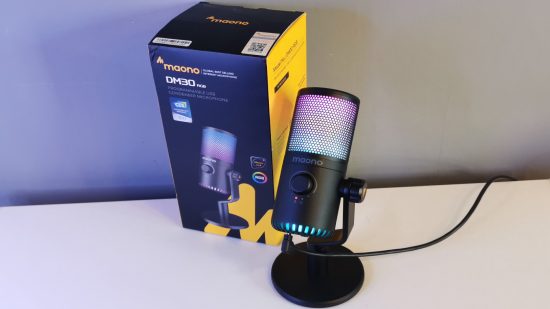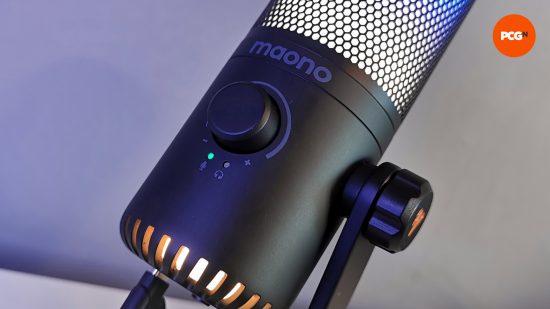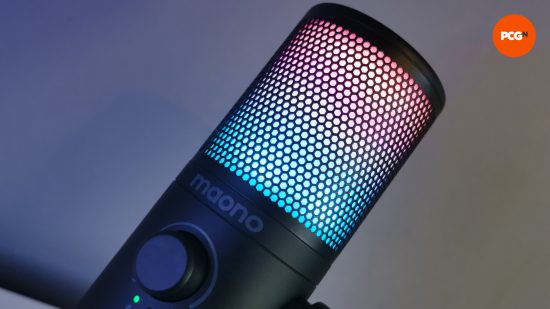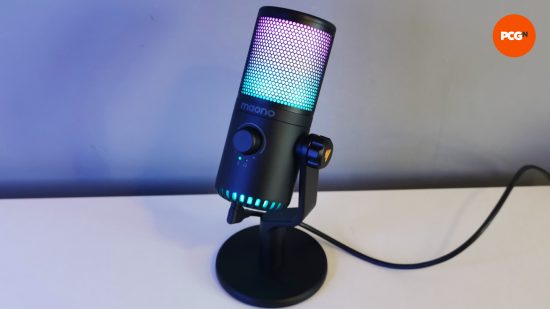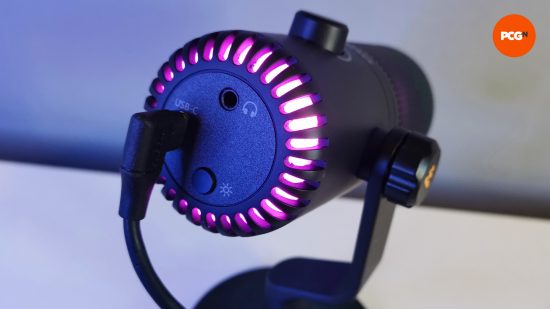Our Verdict
The Maono DM30 RGB may be cheap, but this condensdor microphone has the audio quality, and the classy sleek, black design, that easily puts it on an equal playing field with some of the pricer microphones out there. If you’re looking for a looking for a microphone for streaming, or even want to give podcasting a go without breaking the bank, the Maono DM30 RGB gaming microphone is impossible not to recommend.
- Great value RGB lighting effects
- Easy-to-use software
- Available in other colorways
- Compatible with ⅜ inch and ⅝ inch boom arms
- Not much variety in RGB options
- Button does same RGB effects as software
- Limited EQ options
- Sensitive to keyboard presses/unwanted sounds
Some audiophiles will have you believe that all the best gaming microphones have hefty price tags to match, but sticking purely to the most expensive brands means you can miss out on the opportunity to get your hands on some hidden games, like the Maono DM30 RGB gaming microphone.
The Maono DM30 RGB gaming microphone may not be from as recognizable a brand as the big tech giants we’re used to writing about, but that hasn’t stopped it from easily earning an accolade as one of the best budget gaming microphones we’ve used. During CES 2023, the Maono DM30 RGB received the prestige of being listed as an ‘Innovation Award Honoree’, being listed among products from the likes of Asus, Canon, and Alienware, so we aren’t the only ones who think this microphone is worth the attention.
Why you can trust our advice ✔ At PCGamesN, our experts spend hours testing hardware and reviewing games and VPNs. We share honest, unbiased opinions to help you buy the best. Find out how we test.
Maono DM30 RGB specs
| Maono DM30 RGB Specs | |
| Microphone type | Condenser |
| Pickup pattern | Cardioid |
| Connector | USB Type-C port |
| Lighting | Controllable RGB Lighting |
| Frequency Response | 20Hz-20Hz |
Maono DM30 RGB Features
Setting up the Maono DM30 was as stress free as it gets. Right out of the box, this condenser microphone can be plugged straight into a USB port with its accompanying type-C USB cable, negating the need for an audio interface or any other external power sources besides your desktop PC. The second this DM30 RGB is plugged in, all you have to do is change the audio inputs and outputs in your audio settings, and you’re good to go.
At a glance, the DM30 doesn’t have a lot of bells and whistles, with there only being one large dial sitting on its front. By default, turning the dial left or right will control your volume gain, but pressing in the dial for a longer period will switch the mic over to give you control of your audio monitoring. Tiny LEDs sitting above icons of both a microphone and a pair of headphones will indicate what setting you’re currently controlling. You will of course need to have your headphones connected via the DM30’s 3.5mm headphone jack for the latter control to have any effect – if you’re using another audio output the on-mic monitoring control does nothing.
Pressing and holding the dial a third time will turn off audio monitoring, and one final click will mute the mic altogether. This can be helpful if you need a little snack break in between gaming sessions but don’t want to overwhelm your friends with nauseating eating sounds.
Above and below this multi-functional dial, is the RGB lightning, which can be controlled via a small button found on the underside of the microphone. Pressing this inconspicuous button gives you the ability to change the lighting to a gradient of colors, which will slowly change over time. If the preset gradients aren’t for you, just like the dial, pressing it again will give you more options, in this case switching to a selection of static colors, or you have the option to turn off the RGBs entirely.
Maono DM30 RGB Design
With cheap gaming peripherals, there’s an expectation that they’ll look and feel cheap too, but the instance the Maono DM30 was setup on my desk, I was taken aback by how not too dissimilar it looks in comparison to other high-end gaming microphones on the market. The DM30 sits at around 8.6 inches long, and utilizes a cylinder-shaped form, with a sleek black metal finish, reminiscent of the HyperX QuadCast S, or even the Rode X DM-100.
What it also has in common with these microphones, is the placement of its RGB lighting, which is hidden underneath a patterned grill. The grill on a microphone is typically used to protect the fancy components inside, but Maono has chosen to use its existence to their advantage, opting to display a gradient effect of colors from underneath. Though this decision isn’t unique to the DM30, having them underneath the hexagonal grill makes their effect more subtle, and less overbearing like the lighting on other budget gaming microphones.
The DM30 makes a distinction from the other microphones I’ve mentioned, by having an extra amount of RGB lighting which encompasses the space allocated to the USB Type-C port, and the headphone jack input. Situated around the bottom portion of the mic, this ring mimics either the bottom color of the gradient or whatever static color has been selected.
Here is one of the few instances where I saw clear signs of this mic being on the budget side of things, as through the lighting’s cut-out pattern I could see flakes of plastic, as if someone had been taking out their gaming frustrations on the microphone itself. It’s not hugely noticeable from arm’s length, and likely won’t be picked up on a webcam if you were to stream with the DM30, but it’s nevertheless a small nitpick that I found personally distracting.
The DM30 comes with a stand that allows the DM30 to swivel around 300 degrees, but you’ll want it pointing face up for the cardioid pattern to pick up audio. With these desktop gaming microphones, I always resort to hunching over to get any audio picked up, but luckily the DM30 is compatible with ⅜ inch and ⅝ inch boom arms stands, which are easily attachable.
While I received an all-black version of the DM30 RGB gaming microphone for this review, it is available in other colorways to suit any kind of PC gaming setup. To me, this is something I’d expect with most PC peripherals, but you’d be surprised how many brands just opt for one black variant of their products. With the DM30, you have the option of picking it up in white, pink, and purple, as well as the black variant I’m reviewing at the moment. The purple colorway is more of a metallic blue from what I can see, but regardless, knowing Maono accommodates different PC gaming setups is a win for the DM30 RGB in my book.
Maono DM30 RGB Performance and Software
The sound quality of the DM30 was genuinely surprising, as I wasn’t expecting such crisp clarity, especially when more expensive microphones, like the Logitech G Yeti GX that I’ve reviewed, didn’t produce the sound I was hoping for. The DM30 has a typical cardioid pickup pattern (that pickups sound in front of and to the sides of the mic, but ignores more sounds from the rear), which is great at picking out your voice against the backdrop of any other noise pollution in your home/office/gaming den.
One downside that’s typical of mics attached to desktop stands – rather than on an arm – is the DM30 does strongly pick up the taps of your favorite gaming keyboard or knocks against your desk. However, the nuanced sensitivity of the DM30 makes it a great candidate for being used not only for gaming and streaming but even for recording longer-form audio, like podcasting.
This sensitivity was clear when playing some rounds of the iconic Left 4 Dead with my partner. With the DM30, he was able to hear the constant clicks of my wired Xbox controller, which was brought to my attention. Yet, overall even he was pleasantly surprised by the quality of my voice, thinking I was using my preferred Rode NT1A microphone. With the DM30’s 20Hz – 20kHz frequency response, and cardioid pickup pattern, my audio sounded clear throughout multiple gaming sessions, so long as I didn’t drift away from the front face of the microphone.
The default audio quality is great but the DM30 shines once you download the accompanying Maono Link software. The software features a range of EQ options to amplify the quality of your audio, separated by ‘standard’ and ‘advanced’ sub-menus, with the standard options offering the basic ability to boost gain, as well as pick from a few pre-set audio tone options.
There’s deep, natural, bright, and legacy to choose from. I found myself drawn to the legacy profile as it added an extra bit of warmth to the DM30’s tone. It has since become my go-to option when taking this mic out for a spin.
Maono Link is pretty limited with its EQ options as a whole, with the ‘advanced’ options mostly consisting of allowing you to control the volume gain, headphone audio monitoring, or mute the DM30 altogether, which are the same functions you can already do using the 3-in-1 dial mentioned earlier. This is a common issue I had with Maono Link, as even the RGB options with the software only let you pick between exactly what the small button on the underside of the microphone already allows you to do. With a microphone as budget-friendly as the DM30, I wasn’t expecting much in terms of customization, but as it stands, minus my favorite audio preset, it’s pretty limiting.
There are some more EQ settings, giving you four ‘HPPF and Presence Boost’ presets to pick from, as well as a limiter and compressor, but even after some tinkering, they still failed to bring me the tone that the standard ‘legacy’ preset was able to capture.
Should you buy the Maono DM30 RGB gaming microphone?
At $49.99, the Maono DM30 RGB gaming microphone feels impossible not to recommend, especially if you’re looking to specifically add a condenser mic to your repertoire without breaking the bank. You’d be hard-pressed to find one at this low price, that still looks sleek, offers a flashy range of RGB lights, and brings high-quality crisp audio to the table.
If you’re just in need of a microphone for chatting through Discord with your friends or are new to the world of streaming and want a competent microphone that will still bring an element of style to your stream, the Maono DM30 RGB gaming microphone is a must-buy.
If the Maono DM30 isn’t for you
If you’ve already got enough RGB lights going off no matter where you look, the Razer Seiren Mini is a great alternative. It’s still budget-friendly, and even cheaper than the Maono DM30, which is reflected in its limited feature set and slightly lower sound quality, but it’s still a decent entry-level and very compact option.
If you’ve got a little more cash to play with, the HyperX QuadCast has a similar aesthetic to the DM30, but on a larger scale. While this microphone is more expensive than the DM30, this microphone comes with its own built-in shock mount, which adds significantly to its value.
